Wattage Explained or Does a kettle boil slower in America?
“Come-ooon damn kettle, boil!”
Talking or shouting impatiently at your innocent water kettle is a common sight in homes and workplaces.
Responsible for the time it takes to boil the water is the power consumption, shown in Watt (W).
It is one of our buying criteria for a temperature controlled kettle (see kettle feature comparison).
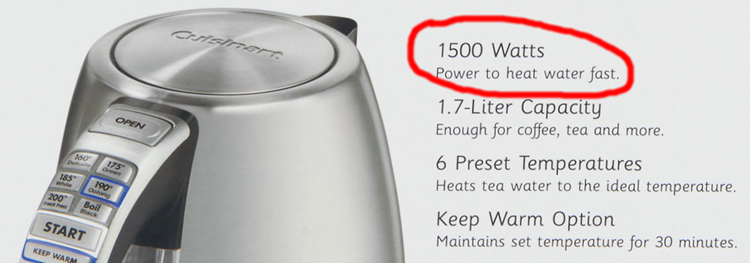
What exactly does it mean?
Watt is the international unit for power (electric, mechanic and thermal).
We are only interested in the electric power which can be calculated with Ampere and Volt:
W = Ampere x Volt
In other words, Watt is the product of the electric current (Ampere) multiplied with the electromotive force (Volt).
To use a mechanical water-analogy, Ampere measures the amount of water (current) flowing through a pipe (conductor) while the Voltage is the water pressure (electromotive force). Both factors determine the power at the end, measured in Watt.
Exactly like your garden hose.
Practical Kettle use
Watt is the rate at which your electric water kettle consumes energy.
Rule of thumb:
The higher the wattage, the shorter the boiling time.
Let’s take this further and calculate the time it takes to boil 1-liter water in a kettle with 2000W.
Let’s assume the tap water is 7°C so you need to increase the temperature by 93°C to reach the boiling point.
We also know the specific heat capacity of water which is 4.186kJ (for more info see here).
It means that you need the heating energy of 4186 Joule to increase the temperature of 1-liter water by 1°C.
time = (temperature increase x heat capacity water) / power in kW
t = (93°C x 4.186kJ) / 2kW
t = 194.649 seconds
t = 3.24 minutes
It takes 3.24 minutes to heat 1l of water in a 2000W kettle.
In theory.
In reality, we know that it takes much longer.
Why?
1. We assume a perfect energy transfer from the heating element to the water which doesn’t happen in reality.
2. Since the heating element is hidden, it needs to heat the bottom of the kettle as well, not just the water.
3. We have not allowed for loss of energy which always occurs.
4. You might not be able to draw the full power under certain circumstances, for example, living in America.
Does water boil slower in America?
Yes, it might.
There are reports of people wondering why their kettles seem to take much longer in the USA, Canada or Costa Rica.
What those countries have in common is the voltage of 110/120V.
Lower voltage could result in less power consumption.
It becomes clearer when we have another look at the equation for Watt:
W=Ampere x Volt
If any of the factors in the equation have a lower value (Ampere or Volt), the product, power (W), will be lower as well.
To demonstrate, we assume that your circuit breaker (or fuse) is set to 10A (if more than 10A is drawn your circuit will trip).
Now we can calculate the maximum power you can get from these two factors:
10A x 110V = 1100W
The maximum power output of your electric circuit is 1100W.
What are the consequences for your kettle?
You just bought the T-fal temperature controlled kettle with 1750W.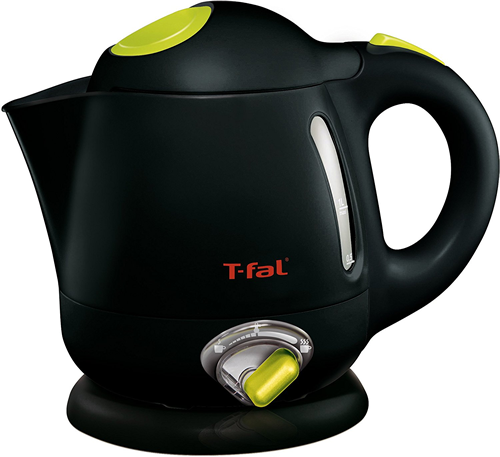
It is cute and advertised to boil a cup of water in 90 seconds but, not in your kitchen.
You write an angry e-mail to T-fal, Amazon and the pope (for good measure) to complain about false advertisement and the bad world nowadays in general.
Don’t.
Read this blog again, relax and save your energy for more important things in life.
Due to the limited availability of Volt (110v instead of 220V in Europe or 230V Australia) and Ampere (10A instead of a 15A breaker/fuse) in your household, your shiny new kettle has only 1100W to heat the water.
It’s power capacity, however, is 1750W.
What should take 90 seconds with 1750W might now require 120 seconds with 1100W.
Therefore a kettle used in America might boil water slower than in countries with higher voltage.
The good News
Unfortunately, parts of this chapter are wrong.
Thanks to Stigs comment below, who pointed out that energy consumption does not depend on the wattage of the kettle. It just influences the boiling time.
I’m keeping the incorrect bits in the chapter, so you can see where I went wrong (just made them grey).
Lower consumption goes in your favor when it comes to your energy bill.
The lower the drawn power, the less energy you use, the less you pay.
It is a win-win situation for you and the environment.
Rule of thumb II:
The faster the boiling, the higher the energy consumption (= energy bill).
It is advisable to check your circuit settings before you buy a high-powered variable kettle. Use the above equation to calculate the maximum output.
Now check the wattage of your favorite kettle with our comparison table on this website.
The power consumption of the kettle you are going to buy should roughly match or be lower than the maximum available power at your kitchen circuit.
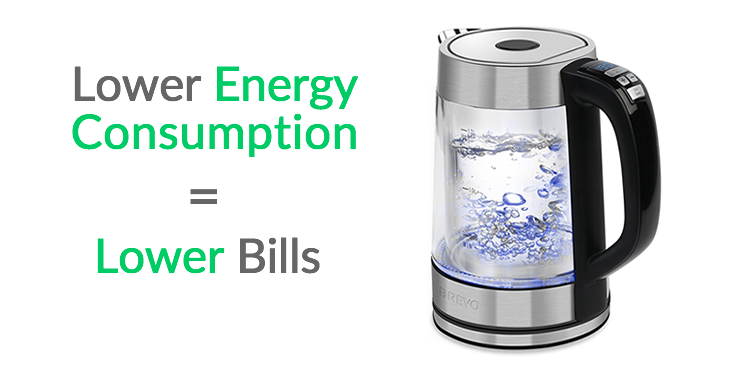
A word to James Watt
James Watt was a Scottish inventor. He dramatically improved the steam engine which played a crucial part in Britains Industrial Revolution in the 18th century.
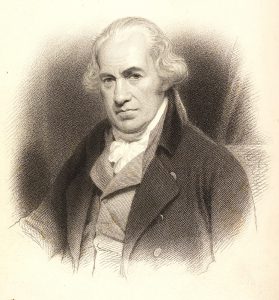
According to an often-told story, Watt took his idea from a boiling water kettle. The power of the steam lifting the lid inspired him to re-design the steam engine and make it more powerful and efficient.
James Watt also came up with the term ‘horsepower.’ There was no other word for it in the 18th century, and the pulling power of horses was a concept everybody understood.
Today a metric horsepower equals 735.5W.
Conclusion
For most people going on the hunt for a new temperature controlled kettle, the wattage is something they ignore because they don’t know what it means.
After reading this blog, I hope you have at least an idea.
Buying a kettle with suitable power consumption is sound advice.
It makes no sense to pay more for something you cannot use and will increase your energy bill as well.
Be smart and love your kettle.
Kettle Whistler
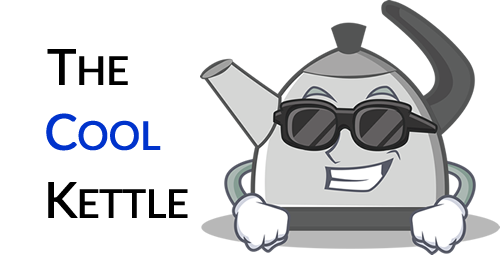
11 Comments
kettle whistler
Please leave your comments below.
Stig
"Lower consumption goes in your favor when it comes to your energy bill. The lower the drawn power, the less energy you use, the less you pay. It is a win-win situation for you and the environment." Eh? It still takes the same amount of energy to boil a kettle full of water no matter the wattage. It just takes longer with a less powerful kettle. It is not cheaper to boil a litre of water in a kettle at 1500 watts than it is at 3000 watts. It's just takes more time to boil at the lower rating. Such a funny statement to make in an otherwise good article.
Martin
It's not a funny statement - it's a wrong one. Thanks for bringing it to my attention. I've changed the article.
David Crowley
In the USA, household voltage is typically 120/240 volts AC. You see it called anywhere from 110 to 125 volts, but 120 volts is the real USA typical. All modern 120 volt household outlets are rated at a minimum of 15 amps. 15 x 120 = 1800 watts. A 10 amp circuit in the USA would be considered antique wiring. Some houshold outlets are wired for 120 volt, 20 amp circuits. Typical high wattage appliances like toasters and hair dryers and portable electric heaters will draw 1500 watts at 120 volts. If you plug a 1750 watt kettle in a circuit designed for 1100 watts maximum, it will blow the fuse/ circuit breaker. It will not, 'take longer to boil the water'. It will not operate. The amp draw is built into the appliance. The limit on the ability to supply amperage is built into the circuitry. If the amp draw of the appliance exceeds the circuit design, it will blow the fuse. The appliance will not operate at the lower amp rating (wattage) of the circuit.
Martin
Thanks David, you are right. I was just making a point with this particular example. Due to the lower voltage, kettles still boil slower than in a country with 220V.
Brian
About 15 years ago in my US home, like almost every home in America has a 240 Volt option as well, I just installed a 240 Volt UK socket in my kitchen which was right above the circuit panel in the basement below. My UK Morphy Richards 3,100 watt kettle is plugged into this socket and it boils water in no time. So basically US supply in most homes is supplied as split-phase which are out of phase by 180 degrees with each other so you get 240 v across the phases A and B. Socket is basically wired as phase H1 connected to "Live" and phase H2 connected to "Neutral" and Earth connected to Earth, where H1 and H2 are the two 120V opposite phases (hot1 and hot2). Wife and family fully satisfied with the result. PS. I grew up in Ireland for first 20 years of my life so I knew how slow US kettles were in comparison to the 240V kettles we were used to growing up.
Martin
Thanks Brian, As you know, the kettle is the most important device in an Irish kitchen. "Stick on the kettle" means time to sit down and have a chat. I didn't know that you could wire a socket with 240V - well done, and thanks for letting us know.
Suxxes
The candle that burns twice as bright burns half as long If a kettle is lower wattage and takes longer to boil does this not equal the kettle that is higher wattage but takes less time to boil?
Martin
Yes, isn't that the whole point of the article?
John Dyer
Will using a 1750 watt power base improve the performance of a 1500 watt water kettle. Same brand pot fits base without issue. Thanks
John
Having a lower wattage kettle doesn't change how much it costs at all. it still take the same amount of energy to heat the water, it just takes a longer time.